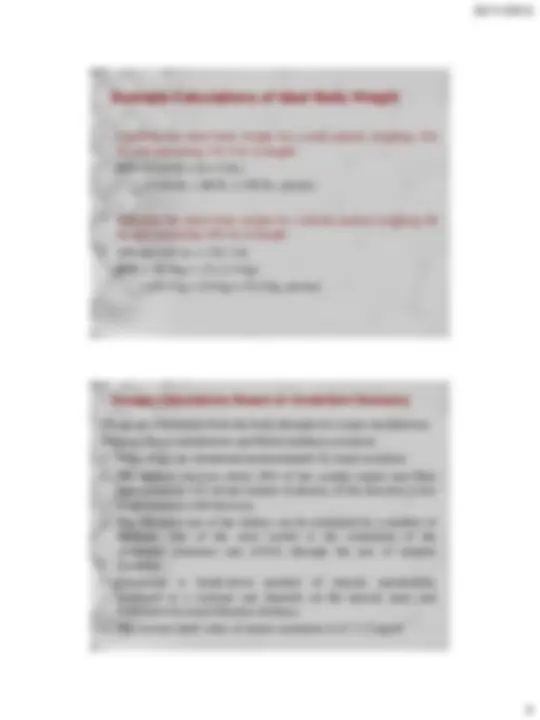





Study with the several resources on Docsity

Earn points by helping other students or get them with a premium plan


Prepare for your exams
Study with the several resources on Docsity

Earn points to download
Earn points by helping other students or get them with a premium plan
Community
Ask the community for help and clear up your study doubts
Discover the best universities in your country according to Docsity users
Free resources
Download our free guides on studying techniques, anxiety management strategies, and thesis advice from Docsity tutors
Calculations for dosing heparin sodium and low-molecular-weight heparins, as well as determining ideal body weight using various formulas. It also discusses the importance of creatinine clearance in dosage calculations.
What you will learn
Typology: Slides
1 / 7

This page cannot be seen from the preview
Don't miss anything!




2
Example: An intravenous infusion contained 20 , 000 units of heparin sodium in
1000 ml of D 5 W. The rate of infusion was set at 1600 units per hour for a 160 - lb patient. Calculate
a) the concentration of heparin sodium in the infusion, in units/ml
b) the length of time the infusion would run, in hours
c) the dose of heparin sodium administered to the patient, on units/kg/minute basis.
a) 20 , 000 units 1000 ml
X units 1 ml X = units/ml
b) 1600 units 1 hour
20 , 000 units X hour X = hours
c) 160 / 2. 2 = 72. 7 kg AND 12. 5 hour = 750 minutes
20 , 000 units 750 minutes
X units 1 minute X = units/minute
X units 1 kg X = units/kg/minute
20 1000
20000 1
20000 1
20000 1
37
7
67 1
Example Calculations of Ideal Body Weight
lb, and measuring 5 ft. 8 in. in height.
160 cm = 63 in. = 5 ft. 3 in.
For males:
For females: CrCl = 0. 9 X CrCl determined using formula for males
serumcreatinineinmg dl
patient sageinyears CrCl /
serumcreatinineinmg dl
patientsageinyears Bodyweightinkg CrCl 72 /
3 - Sanaka equation (for patients over 60 years of age) :
For males:
For females:
4 - Schwartz equation (for pediatric and adolescent patients from
neonates to 17 years of age) :
K is proportionality constant ranging from 0. 33 (for neonates) to 0. 7 (for
adolescent males)
serumcreatinine mg dl
patient sweight kg Plasma g dl CrCl 100 /
' 19 albumin / 32
serumcreatinine mg dl
patient sweight kg Plasma g dl CrCl 100 /
' 13 albumin / 29
serumcreatinine mg dl
glucose, cholesterol, total lipids, creatinine, bilirubin, sodium, potassium,
carbon dioxide and other substances, including drugs following their
administration.
serum is 65 - 99 mg/dL and for creatinine is 0. 5 - 1. 4 mg/dL
blood plasma
If a patient is determined to have a serum cholesterol level of 200 mg/dL, what
is the equivalent value expressed in terms of mmol/L.
M.W. of cholesterol = 387
1 mmol = 387 mg and 200 mg/dL= 2000 mg/L
387 mg 1 mmol
2000 mg X mmol X = 5. 17 mmol/L